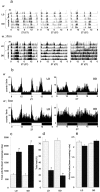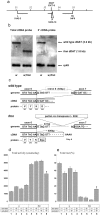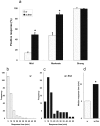Dopamine is a regulator of arousal in the fruit fly
- PMID: 16093388
- PMCID: PMC6725300
- DOI: 10.1523/JNEUROSCI.2048-05.2005
Dopamine is a regulator of arousal in the fruit fly
Abstract
Sleep and arousal are known to be regulated by both homeostatic and circadian processes, but the underlying molecular mechanisms are not well understood. It has been reported that the Drosophila rest/activity cycle has features in common with the mammalian sleep/wake cycle, and it is expected that use of the fly genetic model will facilitate a molecular understanding of sleep and arousal. Here, we report the phenotypic characterization of a Drosophila rest/activity mutant known as fumin (fmn). We show that fmn mutants have abnormally high levels of activity and reduced rest (sleep); genetic mapping, molecular analyses, and phenotypic rescue experiments demonstrate that these phenotypes result from mutation of the Drosophila dopamine transporter gene. Consistent with the rest phenotype, fmn mutants show enhanced sensitivity to mechanical stimuli and a prolonged arousal once active, indicating a decreased arousal threshold. Strikingly,fmn mutants do not show significant rebound in response to rest deprivation as is typical for wild-type flies, nor do they show decreased life span. These results provide direct evidence that dopaminergic signaling has a critical function in the regulation of insect arousal.
Figures





Similar articles
-
How deeply does your mutant sleep? Probing arousal to better understand sleep defects in Drosophila.Sci Rep. 2015 Feb 13;5:8454. doi: 10.1038/srep08454. Sci Rep. 2015. PMID: 25677943 Free PMC article.
-
A genetic screen for sleep and circadian mutants reveals mechanisms underlying regulation of sleep in Drosophila.Sleep. 2008 Apr;31(4):465-72. doi: 10.1093/sleep/31.4.465. Sleep. 2008. PMID: 18457233 Free PMC article.
-
Sleep homeostasis in Drosophila melanogaster.Sleep. 2004 Jun 15;27(4):628-39. doi: 10.1093/sleep/27.4.628. Sleep. 2004. PMID: 15282997
-
[Regulation of sleep and arousal in Drosophila].Seikagaku. 2007 Jan;79(1):39-42. Seikagaku. 2007. PMID: 17319512 Review. Japanese. No abstract available.
-
Searching for sleep mutants of Drosophila melanogaster.Bioessays. 2003 Oct;25(10):940-9. doi: 10.1002/bies.10333. Bioessays. 2003. PMID: 14505361 Review.
Cited by
-
Dopamine acts through Cryptochrome to promote acute arousal in Drosophila.Genes Dev. 2012 Jun 1;26(11):1224-34. doi: 10.1101/gad.186338.111. Epub 2012 May 11. Genes Dev. 2012. PMID: 22581798 Free PMC article.
-
Cul3 and the BTB adaptor insomniac are key regulators of sleep homeostasis and a dopamine arousal pathway in Drosophila.PLoS Genet. 2012;8(10):e1003003. doi: 10.1371/journal.pgen.1003003. Epub 2012 Oct 4. PLoS Genet. 2012. PMID: 23055946 Free PMC article.
-
Dopamine modulates metabolic rate and temperature sensitivity in Drosophila melanogaster.PLoS One. 2012;7(2):e31513. doi: 10.1371/journal.pone.0031513. Epub 2012 Feb 7. PLoS One. 2012. PMID: 22347491 Free PMC article.
-
Dietary modulation of Drosophila sleep-wake behaviour.PLoS One. 2010 Aug 10;5(8):e12062. doi: 10.1371/journal.pone.0012062. PLoS One. 2010. PMID: 20706579 Free PMC article.
-
The roles of dopamine and related compounds in reward-seeking behavior across animal phyla.Front Behav Neurosci. 2010 Oct 12;4:163. doi: 10.3389/fnbeh.2010.00163. eCollection 2010. Front Behav Neurosci. 2010. PMID: 21048897 Free PMC article.
References
-
- Adams MD, Celniker SE, Holt RA, Evans CA, Gocayne JD, Amanatides PG, Scherer SE, Li PW, Hoskins RA, Galle RF, George RA, Lewis SE, Richards S, Ashburner M, Henderson SN, Sutton GG, Wortman JR, Yandell MD, Zhang Q, Chen LX, et al. (2000) The genome sequence of Drosophila melanogaster Science 287: 2185-2195. - PubMed
-
- Andretic R, Shaw PJ (2005) Essentials of sleep recordings in Drosophila: moving beyond sleep time. Methods Enzymol 393: 759-772. - PubMed
-
- Andretic R, Chaney S, Hirsh J (1999) Circadian genes are required for cocaine sensitization in Drosophila Science 285: 1066-1068. - PubMed
-
- Andretic R, van Swinderen B, Greenspan RJ (2005) Dopaminergic modulation of arousal in Drosophila Curr Biol 15: 1165-1175. - PubMed
Publication types
MeSH terms
Substances
Grants and funding
LinkOut - more resources
Full Text Sources
Other Literature Sources
Molecular Biology Databases
